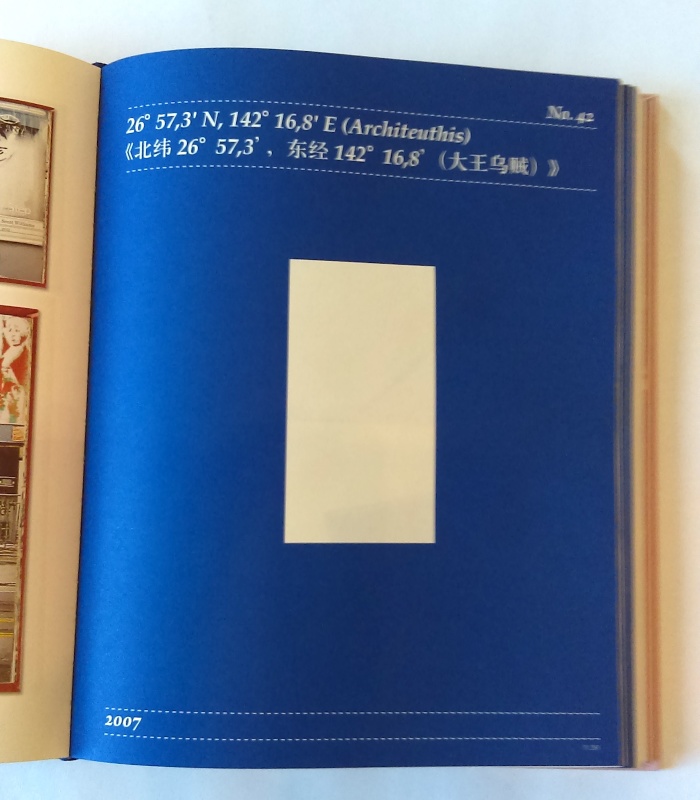Diamond Leaves: Artist Books from around the World (Catalog)
Diamond Leaves: Artist Books from around the World (Catalog)
Date
2012
Media
Offset print
Format
Book
Dimensions
11.6 × 9 × 1.5 in
Publisher
Guangxi Normal University Press
Collection
Collection Development, Limited Edition Artists Books$ 16,200.00
1 in stock
View Collectors
Athenaeum Music & Arts Library, La Jolla
Bainbridge Island Museum of Art
Boston Athenaeum
College of Saint Benedict & Saint John's University
Cornell University
Getty Research Institute
Koninklijke Bibliotheek, Nationale Bibliotheek van Nederland
Metropolitan Museum of Art (MET)
Minneapolis Institute of Art
Smith College Museum of Art
Stanford University
Swarthmore College
The New York Public Library (NYPL)
The University of the Witwatersrand, Wits Art Museum (WAM), Jack Ginsberg Centre for Book Arts
University of California, Berkeley (UCB), The Bancroft Library
University of California, Irvine (UCI)
University of California, Los Angeles (UCLA), Hammer Museum
University of Connecticut (UCONN)
University of Delaware Library
University of Minnesota
University of Southern California (USC)
University of Toronto
University of Wisconsin-Milwaukee
University of Wisconsin, Kohler Art Library
Walker Art Center
Wesleyan University, Olin Library
In English and Mandarin.
This is an extremely rare and pristine copy of one of the most important reference books for the international field of artists’ books and book history. The book is the catalog for the largest exhibition of artists’ books ever mounted, the first exhibition of the Diamond Leaves Triennial at the Central Academy of Fine Art Museum in Beijing. Signed by co-curators and editors Marshall Weber and Xu Bing.
“I have long dreamt of holding an exhibition that would introduce the idea of international artists’ books. While I had done a large number of book-related works, I had never heard of the form itself, “the artists’ book,” until the 1990s, when I worked as a visiting artist in the United States. . . . As digital publishing has rapidly replaced printed media in recent years, we have seen the rise of the electronic book. Consequently, the artists’ book becomes more than mere reading material; it maintains the cultural dignity of books. We are actually experiencing the transformation of reading material, in which books may be transmuted into pure art or a symbol of art.”
—Xu Bing, from the Foreword
“A decade in the making, this exhibition illuminates six of the dozens of branches of book types that spring from the tree of book history; early European codices, early Chinese printed books, Soviet constructivist books, livre d’artiste, artists’ books, and zines. Rather than being a comprehensive survey of artists’ books, the exhibit focuses on unique (singular) and limited edition (under 100 copies) books created in the 21st Century while also providing examples of Chinese and Western historical precedents. These books are artists’ books by virtue of being primarily hand-made or made on machines controlled by the artists. Though the subject matter is diverse, there is an emphasis on: 1) books that balance the usage of image, tactile experience, and material form, 2) books whose materials and structures reflect their subject matter, and 3) books that integrate text with image. We, the curators, are not seeking to define what an artists’ book is. We are far more interested in what an artists’ book can be and how it can function as both fine art and an experimental laboratory for global visual language development.”
—Marshall Weber, “The Roots of the Matter,” page 18–30
“ . . . The extraordinary works selected for Diamond Leaves deliberately push us as readers and as viewers. Regardless of how they positioned themselves on the spectrum of the book arts, these works insist that we consider and experience them in new ways. . . . As this discussion has suggested, ‘Diamond Leaves’ is not a mere survey of the artists’ book. We are instead dropped into the midst of the modern book, and much is asked of us. Surrounded by this astounding array of the 21st –century artists’ books, we are absorbed into the process; we enter into the dialogue that each of these works demands of us in order that they be comprehended.”
—Mark Dimunation, “When Left to Their Own Devices: Meaning and Intention in the Modern Artists’ Book,” page 31–35
















